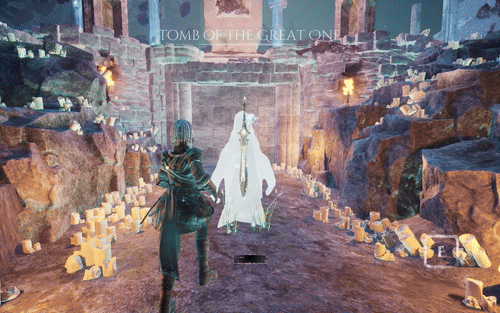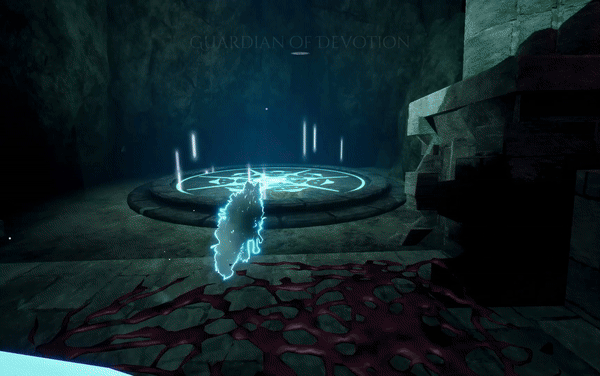
Role: Creative Director; Narrative Designer; Cutscene Designer
Team: Fenris Games; 27 members
Time Spent: 1 year
Program: Unreal Engine
Overview: A 3D action-adventure story game that explores themes of grief and accepting loss. It follows a girl named Astrid who enters the afterlife in attempt to revive her pet wolf.
Shadow's Grove

Official game trailer I created in Adobe After Effects

A quick look at the game's visuals

Creative Outlining

Narrative Direction
I joined Fenris Games as a narrative designer after the game had already been in production for a full semester, focusing on nailing down the narrative direction of the game which had previously been inconsistent. The tangible narrative events had already been outlined – a girl follows her deceased wolf into the afterlife – but I began to put more weight on the meaning behind the events. I wrote up a thematic outline and established Shadow’s Grove as an exploration of learning to move forward from grief, which served as the basis for both my own as well as the rest of the team’s creative decisions.
Character Outlines
I then began implementing the narrative thesis into the game, establishing the significance of each major character to help highlight the themes. In designing the two leads, Astrid and Eri, I placed careful attention into how their different personalities drive a lively dynamic between them, which created the basis for several animation and gameplay choices. After highlighting their bond as central to the narrative thesis, I wanted to ensure that the player would feel the weight of it as they play.


Worldbuilding

I designed the world, known as the Valley of Souls, through the lens of the game's narrative thesis, tying the backstory and mechanics of it to the greater themes of grief, stagnation, and learning to move forward. I also collaborated closely with the art team, and after seeing that many of the artists enjoy high fantasy, I leaned further into the ever-changing nature of the Valley of Souls to allow them to go all out in creating a space that feels alive and fantastical, which reflects the core ideas of managing shifting, conflicting emotions.
I then provided several pages of both real world and mythological references for artists to draw from, including images, descriptions, and information on how they connect to Shadow's Grove. The areas of inspiration include Gjallarbrú, Gjöll, Hel, Yggdrasail, and Draugs from Norse mythology, as well as Nidaros Cathedral in Norway.
A factor I placed a lot of attention on is how the world could be emotionally enthralling, as I had written corrupted spirits as beings who attempt to keep people psychologically blocked from wanting to move forward. The below excerpts demonstrate how I translated these ideas into various creative direction decisions.




Ludonarrative Design
As our team had little scope for cinematics, I implemented a combination of dialogue and ludonarrative techniques to fill gaps where players struggled to follow the narrative. The methods I applied included environmental storytelling, lore interactables, in-universe tutorialization sequences, and location-based user interface popups. Each piece came together to form a cohesive whole without needing to overdo either exposition or the use of any individual element.

Overview

In terms of dialogue, I placed a variety of different beings throughout the afterlife. As Astrid, I enabled players to engage with spirits and divine beings who grant powers and help them understand their surroundings. As Eri, I pushed players to howl atop platforms on the floor in order to speak with spirits who help him process his upcoming death. These techniques allowed me to communicate information in a diagetic way, as exposition and tutorials are consistently disguised.
Chained Sword System

The key lore interactable system I created is that of Chained Swords: interactable sword spirits that build upon the lore and guidance design. I divided them into purified and corrupted swords, both of which I provided with different priorities and manners of speaking to keep the player guessing.
I then locked interactions so that sword spirits may only be spoken to while the player is controlling Astrid, which ensures that the player will view the two main characters as separate beings with different affordances.
A Major Pivot / Communication Issue Resolution
At one point during production, our team had to cut a massive narrative cutscene where Astrid and Eri are reunited in order to compensate for tasks being delayed by communication issues. This choice weighed heavily on narrative, as that moment had initially been a key emotional beat, but I took steps to quickly pivot and improve our team's task delegation and production process.
In particular, I designed a new ludonarrative sequence to replace the cutscene. In this scene, instead of Astrid rescuing Eri from a cage upon defeating enemies, Astrid gets overwhelmed by enemies and blacks out before Eri breaks out of a cage to save her. Through this change, I increased the emotional connection between the player and Eri, as they are powerless to defeat enemies without him, and therefore feel the weight of his addition much more heavily. I also made the main antagonist, a corrupt deity, speak to Astrid while she is blacked out, encouraging her to cooperate with Eri to destroy spirits. My intention was to play into the themes of struggling to let go, as the main antagonist in this moment is pushing Astrid and by extension the player to remain both attached to and reliant on Eri, pursuing a destructive path as opposed to one of peaceful resolution before learning to let go.
Upon outlining the sequence, I created a punctual document with brief, to-the-point descriptions of the necessary additions and the action items associated with them, as well as one with references. This decision helped the team members understand exactly what needed to be done and why, which pushed them to take action much sooner compared to when they had been relying on a more general task list that production had provided before. I additionally spearheaded a team meeting to address associated communication issues, ensuring teammates understood that these concerns were not coming from a place of accusation or viewing them as bad designers, but one of wanting to find effective ways of communicating so that we may make the best of our circumstances.




Cinematics
I additionally did the camera work for two cinematics in Unreal Engine's Sequencer. I implemented these in moments where a path that had previously been inaccessible opens up, highlighting player progress and in-game environments in a dynamic way.



I Learned About:
1
Working Under Constraints
I had to learn to work under a tight scope, as I joined the team a few months into development at a point where we had to cut more content than we could add. It forced me to find creative ways to implement the game's narrative so that I could ensure our tech and art teams were not overwhelmed. There were times where major cinematic beats and character appearances had to be reworked or removed, leading me to learn a variety of ludonarrative storytelling techniques to compensate.
2
Communication
Fenris Games finalized at 27 members, and the roster shifted a lot throughout development. I took an active role in facilitating communication, as I voiced a number of problems, kept professors updated, and took feedback with an open mind. I also helped with production by integrating action items into my design documentation to ensure that tasks would not be lost, and attended regular meetings with each discipline to check up on progress.
3
Driving a Thesis
Working as a Creative Director taught me a lot about how to establish and drive a cohesive vision. I highly value holistic design, and wanted to ensure that each element of the game would reflect its core ideas. In pursuit of such, I kept in active talks with our art, tech, and audio teams, breaking down complex ideas so that they could be easily understood. It helped me work with the team's constraints, as focusing on the core of the game ensured I knew what cuts could be made.